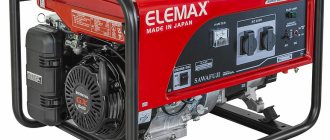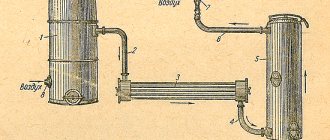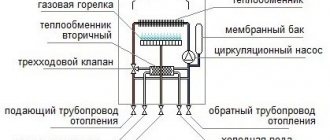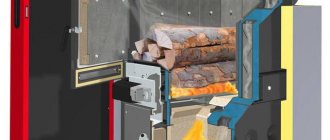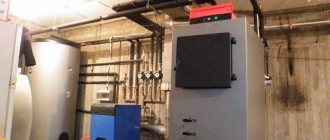What is a wood-burning gas generator?
The gas generator has a fairly simple design, since all the processes taking place in it are based on the pyrolysis combustion of wood. That is, the idea of gas generators is based on pyrolysis boilers, where wood burns in a lack of air, releasing a large amount of various gases. Below we will provide information about the structure of this device.
- Frame. It is usually made from sheet steel. All elements are connected by welding. In general, the body can have either a cylindrical or rectangular shape, although the cylinder shape is more common and looks aesthetically pleasing. At the bottom, the legs are welded on which the structure will stand.
- Bunker. It is also made from low carbon steel sheets. Like the body, the hopper can also be shaped like a cylinder or rectangle . It is brought inside the housing and attached to the walls of the housing using bolts. There should also be a lid covering the hole at the top that leads into the hopper. Asbestos or some other material is used as a sealant.
- The combustion chamber. It is located at the bottom and is usually made of steel with a high chromium content. Here solid fuel combustion occurs under conditions of insufficient air supply. There are asbestos cords between the inner walls of the housing and the combustion chamber. On the side walls of the combustion chamber there are several holes, or as they are also called, air supply lances, through which air is supplied to the combustion chamber. These tuyeres are connected to an air distribution tank, which communicates with the atmosphere. When air leaves this container, it overcomes the check valve. The function of this valve is to block the release of gas formed during the burning of wood to the outside.
- The grate is located at the bottom of the device. Its function is to maintain hot fuel. Also, through the numerous holes of this grate, the ash formed during fuel combustion enters the ash pan.
- Loading hatches. There are three such hatches in the design of household gas generators. The first one is located on top, its lid folds horizontally. Asbestos cords are used as sealing during closing and sealing. In modern models, in the area where the hatch is attached, you can find a special spring-shock absorber, which automatically comes into action if the pressure inside the device exceeds a certain norm. Under the action of this spring, the hatch tips over. There are two more loading hatches on the side of the structure. The first of them is located at the level of the recovery zone. This hatch is used to load fuel into this area. The lower hatch is located at the lower end of the device, at the level of the ash pan. It is used to clean it. The gas formed during the combustion of solid fuel is removed from the upper part of the structure. For this purpose, there is a special gas outlet pipe.
Next, we will consider the processes during which flammable gases are released from wood. In general, the entire structure can be divided into several zones:
- Drying zone. It is located in the upper part of the structure, immediately below the loading hatch. Here the fuel dries quickly due to the fact that the temperature in this zone reaches about 190 degrees Celsius.
- Dry distillation zone. It is located below the drying zone. The dried fuel here undergoes charring due to the fact that the temperature reaches up to 500 degrees. During these processes, tars and some acids of organic origin are removed from the fuel.
- Combustion zone. Located at the bottom. The fuel enters here and burns at a temperature of 1200 degrees. Air is supplied through special tuyeres. During combustion, carbon monoxide and carbon dioxide are released.
- Recovery zone. Gases released during fuel combustion rise upward and reach the reduction zone. Coal is loaded here through a special hatch, which is held on a grate. Carbon monoxide and carbon dioxide react with coal. When carbon dioxide and coal react, carbon monoxide is formed during the reaction. But coal contains water, which is also active towards gases. As a result of all these reactions, carbon monoxide, carbon dioxide, hydrogen, methane, some volatile unsaturated hydrocarbon compounds, and nitrogen are formed. This mixture of gases is purified of all impurities and then mixed with air. This is the end result. The resulting mixture of gases can be used for domestic needs.
How does a gas generator work?
To understand what benefits a gas generator can have in a household, you need to understand its operating principle, and then its structure. Then it will be possible to estimate the costs of its production, and most importantly, what kind of result will be obtained.
So, a pyrolysis gas generator is a complex of components and assemblies designed to separate a mixture of combustible gases from solid fuel for the purpose of its use in internal combustion engines.
If wood is burned in a closed space, limiting the supply of oxygen, then the output can be a mixture of combustible gases. Here is their list:
- carbon monoxide (carbon monoxide CO);
- hydrogen (H2);
- methane (CH4);
- other unsaturated hydrocarbons (CnHm).
An effective wood gas generator must not only produce a combustible mixture, but also make it suitable for use. Therefore, the entire cycle of obtaining fuel for internal combustion engines can be safely called a technological process consisting of the following stages:
- gasification: wood does not even burn, but smolders when the amount of oxygen supplied is 33-35% of that required for complete combustion;
- primary rough cleaning: volatile particles of combustion products produced by wood gas generators after the first stage are separated using a dry vortex filter - a cyclone;
- secondary rough cleaning: carried out in a scrubber - purifier, where a flow of fuel is passed through water;
- cooling: combustion products with temperatures up to 700 ºС pass through it in an air or water heat exchanger;
- fine cleaning;
- sending to the consumer: this can be pumping fuel by a compressor into the distribution tank or supplying it to the mixer, and then directly to the internal combustion engine.
You can consider the design and operating principle of an industrial gas generator in the technological diagram presented below:
The full gas production cycle is quite complex, since it includes several different installations. The most basic one is a gas generator, which is a metal column of cylindrical or rectangular shape, narrowing downward. The column has pipes for air and gas outlet, as well as an access hatch to the ash pit. The unit is equipped with a lid on top for loading fuel; the chimney is not connected to the body; it is simply missing. The combustion and pyrolysis process taking place inside the column is well reflected by the gas generator diagram:
Without going into the intricacies of the chemical reactions taking place inside the column, we note that the mixture of gases described above is obtained at the exit from it. Only it is contaminated with particles and combustion byproducts and has a high temperature. Having studied the drawings of gas generators of any design, you will notice that all other equipment is designed to bring gas back to normal. Air is forced into the combustion zone by a traction or blowing machine (in simple words - a fan).
It must be said that a homemade wood-burning gas generator is made by home craftsmen with a less complex design and the technology for releasing gas in it is somewhat simplified, which will be discussed below.
Advantages and disadvantages
Wood-burning gas generators have many advantages and few disadvantages.
The advantages are as follows:
- The efficiency of gas generators reaches 90%. Compared to them, solid fuel boilers have an efficiency of only 75%.
- Wood burns in gas generators for a very long time. Just adding firewood can be enough for 20-25 hours of device operation. And if you use coal as fuel, then one bookmark can be enough for several days.
- The fuel usually burns completely, leaving a minimum of ash behind. Therefore, when using gas generators, there is no need to constantly clean the ash pan.
- Some devices have automated systems for regulating the combustion process.
- During combustion, the release of harmful substances is minimized. That is why there are currently active attempts to use gas generators in cars to reduce the emission of harmful substances into the atmosphere.
- The family budget is significantly saved.
- Long firewood can be loaded into the combustion chamber, that is, there is no need to cut it into small pieces. Firewood up to 1 meter long can fit into the firebox.
- Any solid fuel can be used as fuel.
And now about the shortcomings. There are only three of them:
- Most devices have fans at the air outlet from the air separation box. They can work mechanically, but in many models they require electricity to function. Because of this, the operation of the generator becomes volatile.
- Condensation may form inside the chimney. To avoid this, the temperature should be kept at 60 degrees.
- Factory designs are very expensive. Therefore, you should make gas generators with your own hands. Drawings can be found on the Internet.
Nuances of operating a gas generator
It is mistakenly believed that a homemade gas-generating unit is capable of operating on wood with a moisture content of up to 50%. It is worth considering that the higher the fuel moisture level, the lower the efficiency of the thermal power device. To optimize the work process, it is worth using hot gas to heat and dry firewood in the bunker. For these purposes, a gas pipeline is laid between the housing and the loading chamber: part of the thermal energy is spent on drying fuel resources.
Combustible gas, so necessary for heating houses, cooking, as fuel for cars and other useful devices, is not only extracted from underground. The source of this valuable product can be firewood, peat, wood waste, coal and even certain types of garbage, for example, pieces of old linoleum or removed parquet, plastic unsuitable for further use, etc. To obtain gas in this way, you will need to purchase a special device or make a gas generator with your own hands. How to build it yourself - we’ll talk about that now.
Kinds
Gas generators can be classified according to the type of fuel combustion. So, there are three types:
- Direct combustion generators. In designs of this type, air is supplied to the combustion chamber from below through a grate. The gas outlet pipe is located in the upper part of the structure. Such structures are designed for burning coal or anthracite.
- Inverted combustion generators. In such designs, air is supplied to the combustion chamber not from below, as in the first case, but directly at the level of the combustion zone. But the gases are removed at the level of the ash pan, and can be used to heat the newly loaded fuel.
- Horizontal combustion generators. In structures of this type, air is also supplied through special forms at the level of the combustion zone. Gas is also taken from the side through a pipe located behind a special grille, at the level of the combustion zone. The zone in which gases are extracted is small in this case. It is concentrated mainly between the lance and the grate, behind which there is a gas outlet pipe.
How to make it yourself
Factory-made gas generators are very expensive, so not everyone can afford to purchase such a unit. But the simplest version of gas generators can be made yourself at home. It will not cost very much, and the manufacturing process itself is not particularly difficult. The most important thing is to take a drawing of a simple gas generator. They can be found on the Internet and printed.
The following will provide step-by-step instructions that should be followed when making a generator with your own hands:
- The first step is to make the body of the future design. It is made from sheet metal. The sides are connected by welding. The legs are also attached from below.
- Next, the bunker is made. It can also be of any shape. Low carbon steel is used for its manufacture. The finished hopper is placed in the housing and secured there with bolts. A lid is made for the bunker.
- Then a container is installed at the bottom of the bunker, which will serve as a firewood combustion chamber. It can be made from an old gas cylinder. Attention: Before using the cylinder, it is necessary to fill it with water, since when cutting off the top part, the remaining gas may ignite.
- The upper part of the cylinder is cut off, the remaining part will be the combustion chamber.
- Now you need to make an air distribution box. It is installed outside the housing. A check valve should be installed at the outlet of the box. The installation location should be selected based on the drawing.
- The grate is made of cast iron. It is also installed based on the drawing used.
- Now you need to make devices for supplying air and removing gases. They are installed at the top or bottom of the device. The installation location is determined according to the drawing.
- The very last step is installing the chimney.
Gas generator design
So, let's move on to the specific question of our article: how to make a wood-burning gas generator yourself? Its design should include:
- Frame. It is usually made either from a pipe with a wall thickness of at least 4 mm, or from sheet iron with the same thickness. The shape can be round or rectangular.
- Bunker for loading fuel. It is made of low-carbon steel and is inserted into the body, secured with bolted connections. This element must be equipped with a lid, which must fit tightly.
- The combustion chamber. It is part of the bunker and is located underneath it. The chamber is made of heat-resistant steel; you can use a gas cylinder.
- A neck is connected to the firebox from below; resins will be deposited here.
- An air distribution box to which a check valve is connected. This device is usually a separate unit. That is, it is not placed in the gas generator housing. Some craftsmen install a fan in front of the box, which pumps air into it. This allows you to use even freshly cut trees as fuel.
- Grate. This element is most often made of cast iron. It is best to take into account the movable middle part in the design; with its help, you can easily tilt the grate to clean the ash pan. To control the moving part, a special lever is installed outside the housing.
- Two doors must be installed: one for loading firewood, the second for cleaning the ash pan. In both cases, care must be taken to seal them tightly. Each master comes up with his own method of sealing. There are even very unique ones. For example, installing a spring that cushions the door. By the way, the hatch used for loading firewood can also be used as a relief valve if there is a need to relieve the gas pressure inside the bunker.
- The gas generator also includes filters, a cooler, a mixer and pipes for various purposes.
Source
Required materials and tools
In order to make a gas generator with your own hands, you must have the following tools and materials:
- Barrel for the body of the structure.
- Old gas cylinder.
- Filters for gas purification, as well as valves. They can be found in hardware stores.
- Bolts (several pieces).
- Welding machine.
Finally, it should be noted that the process of making a generator does not contain any particular difficulties, so anyone can make it themselves. The main thing is to follow the step-by-step instructions given here.
